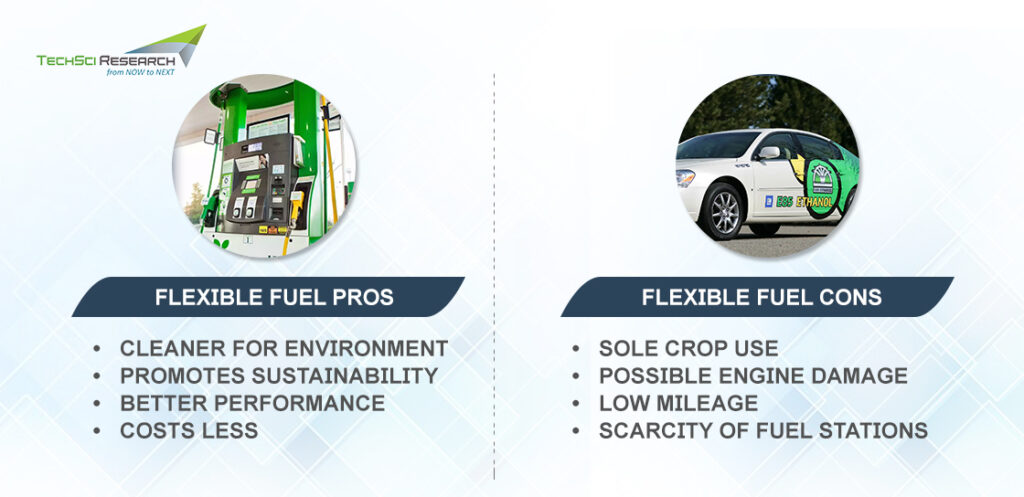Flex Fuels: Sustainable Alternative to Gasoline
The ever-increasing number of vehicles on roads harms the environment and puts strain on the limited sources of conventional fuels like oil and petroleum. Vehicular pollution is a significant contributor to the greenhouse gas emissions like carbon dioxide, carbon monoxide, and sulfur dioxide that reduce the air quality and lead to global warming. Whereas conventional fuels are not renewable, the growing energy demands lead to their high prices. Therefore, governments worldwide are desperately looking for measures to reduce the pollution from vehicles. Electric cars are relatively more eco-friendly than gasoline-powered vehicles, but they are expensive and require adequate charging infrastructure. Flexible fuel or flex fuel is another alternative for conventional fuels due to their significant benefits for the environment and cost-effectiveness. Made with a combination of petrol and bioethanol, flex fuel contains less energy per liter than petrol.
While gasoline is formed from decayed organic compounds, ethanol is an organic and colorless compound derived from sugarcanes through the process is known as fermentation. In layman’s terms, ethanol is simple alcohol with a pleasant odor. The flammable property of ethanol makes it ideal for the mixture with petrol. The blend of petrol of ethanol reduces fuel consumption, and it is also a more cost-effective solution to using gasoline alone. Besides, ethanol present in petrol lowers the emission of harmful gas coming from the vehicle’s exhaust. Another advantage of flex fuels is that farmers can earn more with increased demand for sugarcane. The reduced dependency on fossil fuels for meeting the power needs for automobiles would further decrease the overall global price of petrol and diesel.
Flex fuels are categorized into different categories depending on the ethanol concentration in the blend. For instance, with only 5% ethanol by its volume, flex fuel would be named E5, whereas with 85% volume, it will be denoted as E85. The Flexible-fuel vehicle market is largely concentrated in four markets, Brazil, the United States, Canada, and Europe. Although ethanol flexible-fuel vehicles can run on any mixture of gasoline and ethanol, most automobiles in North America and Europe are optimized to run on E85, a blend of 85% anhydrous ethanol fuel with 15% gasoline. In these markets, the flex fuel’s ethanol content could reach 70% to reduce ethanol emissions at low temperatures. However, Brazilian flex fuel vehicles are optimized to run on any mix of ethanol and gasoline, even with 100% hydrous ethanol fuel (E100); hence they are known as ‘total flex’ or simple ‘flex’ cars in the market. More than 90% of the vehicles sold in Brazil consist of flex fuel engines.

How Flex Engines are Different from Standard Gas Engines?
Components of flexible fuel cars are almost the same as those found in conventional gasoline-only cars. However, some special ethanol-compatible components are required due to different chemical properties and energy content in ethanol. Flex engines are specifically designed to withstand the corrosive and conductive nature of ethanol. Ethanol has different chemical properties than gas and burns hotter, making it challenging to use in standard engines. Running ethanol in traditional engines regularly will rust and break it down. A flex engine can help to overcome these technical challenges. The internal engine components like valve seats, piston rings, and other parts are composed of materials that do not corrode easily, which helps lower the possibility of damage and prevent ethanol from cleaning away engine lubricants.
All electric parts of the fuel system, including wiring, are insulated as ethanol has a higher conductivity. The fuel filler parts have anti-spark features to reduce the chance of stay sparks that might cause dangerous flare-ups. Besides, the fuel injectors are created to achieve higher fuel flow rates since ethanol has a low energy density than gasoline, so the engine requires more fuel for power generation. Unlike gas engines, flex fuel requires a minimum fuel system and engine modifications for efficient operations.
Pros of Transitioning to Flex Engines
Cleaner Fuel
Burning flex fuel for power produces fewer toxic fumes and particles compared to pure petrol or diesel; hence it is considered a cleaner fuel. Flex fuels also contribute to the less greenhouse gas emissions, so they are a more eco-friendly than traditional gasoline. More concentration of ethanol in flex fuels ensures less damage to the air in surroundings. For instance, manufacturers do not add polyaromatic hydrogens (PAH) in E85 since it has a high octant amount while adding PAH to gasoline to increase its octane rating. But the burning of PAH releases more harmful components that degrade air quality.
Promotes Sustainability
Since ethanol is derived from plants such as corn and sugarcane, one can never really run out of it, unlike petroleum, which takes millions of years to form. Manufacturing sugarcane leaves a lesser carbon footprint than processing and refining conventional fuels. As cultivation methods are improving, the carbon intensity of corn production is decreasing. Besides, greater dependency on biofuels would decrease the energy demand for fossil fuels and thus promote sustainability.
Better Performance
CNG-fueled cars produce less power than their petroleum components, but it is not the case with flex fuel vehicles. Like petrol, flex fuel delivers similar and sometimes even better performance. The flex fuel engine might have different components but works exactly like an internal combustion engine, hence there is no impact on a vehicle’s mobility with a change in fuel. Flex fuel can give your engine 100 more horsepower if your engine is tuned right. Since ethanol has high octane, it combusts completely, which creates less denotation and knocking and maximizes the engine’s power. Also, flex fuel provides a thermodynamic cooling effect due to lower combustion temperatures, which prevents heat build-up in the engine and loss of less power.

Costs Less
Gas prices are skyrocketing across the globe due to increasing energy demands in every industry. However, flex fuels can help one reduce their expenditure and save money. Ethanol costs lesser than gasoline, so their blend is relatively affordable. Besides, flex fuels prevent the need for frequent engine maintenance as they burn a lot cleaner than regular gasoline, which keeps fuel lines and exhaust systems clean for a more extended period. If the engine stays in good health, your repair and maintenance costs can become much less.
Are Flex Fuel Vehicles Good Option for India?
India is the third-largest oil importer, shipping around 3.9 million barrels per day. In FY21, India’s oil import bill stood at USD62.7 billion. Additionally, vehicular pollution accounts for severe air pollution in the northern part of the country. Hence, the government has planned to reduce pollution and reduce oil imports by creating fuel substitutes like ethanol, hydrogen, and electricity. The use of flex fuel with 20% Ethanol content can help India save USD4 billion per annum. Also, flexible fuel vehicles (FFVs) would help India meet its commitments to reduce emissions. As per reports, carbon monoxide emissions could be lowered by 50% in two-wheelers and 30% in four-wheelers compared to petrol using flex fuels.
Currently, petrol sold in India has an average of 8% ethanol, and existing vehicles manufactured in India are optimized for E10. The higher blending of ethanol would mean high manufacturing costs, which will reflect flexible fuel vehicles’ prices. Auto manufacturers like Toyota, Maruti Suzuki, and Hyundai are ready to comply with government regulations on flex fuels with at least 20% ethanol concentrations. Bajaj Auto and TVS Motors plan to roll out two-wheelers with flexible fuel with 100% ethanol concentration. Under the Euro IV emission norms, the government has also advised automobile makers to manufacture flex fuel strong hybrid electric vehicles (FFSHEV), which houses electric motors that power vehicles alongside traditional petrol engines.
India can meet most of its ethanol demand indigenously, given the size of the country’s sugarcane and grain production. Increased dependence on ethanol would help boost the farming sector and generate employment for lakhs of people.
Auto companies in India are already facing a major challenge of meeting the demands for electric models and enhancing sustainability in their operations. The new mandates introduced for the production of FFVs could further place auto manufacturers in a tight spot as they would require additional investment in production lines and technology advancements to change the engine and other associated components such as piston, cylinder block, cylinder head, injectors, fuel rail, etc., for flex fuels. However, automakers in Brazil could largely benefit from the new mandate as they are already developing FFVs.
The new policy on flex fuel will come into force from April 1, 2025. The additional cost impact could raise the price of four-wheelers by INR 25,000 (USD 336) and INR 12,000 (USD 161.43) for two-wheelers, which could vary depending on raw material price movement, technology costs, etc.
Challenges Associated with the Use of Flex Fuels
Greater consumption of sugarcane and corns for manufacturing flex fuels could push feed prices. Besides, corns are susceptible to damage with changing weather conditions, which may affect the harvest. Possible engine damage is another concern associated with the use of flex fuel vehicles since ethanol easily absorbs dirt and is highly corrosive.
One of the main problems associated with FFVs is low fuel consumption as they take 1.5 times as long as to provide the same energy as petrol vehicles. Besides, the frequency of gas stations that offer ethanol is less, affecting the accessibility and affordability of flex fuels.
Blog : https://www.techsciresearch.com/blog/flex-fuels-sustainable-alternative-to-gasoline/289.html



